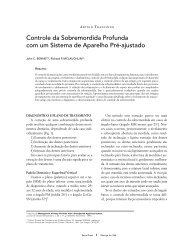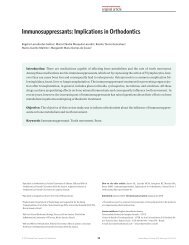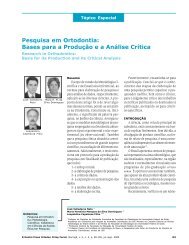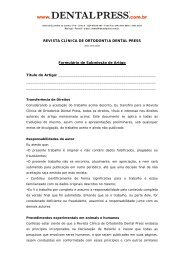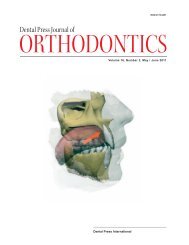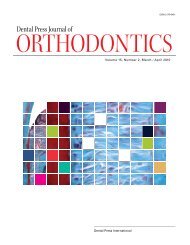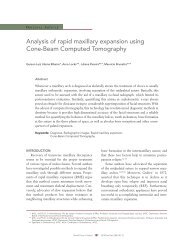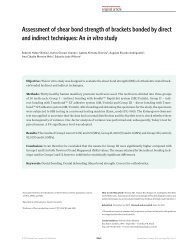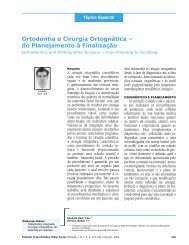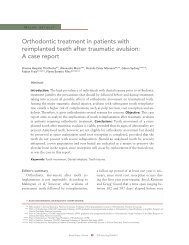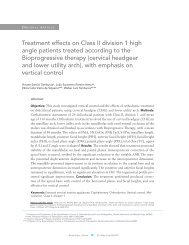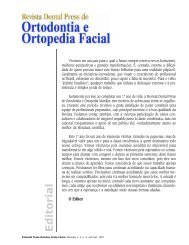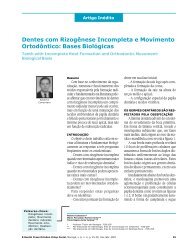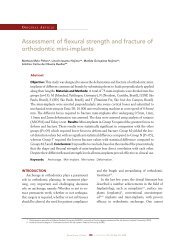Dental Press
Dental Press
Dental Press
Create successful ePaper yourself
Turn your PDF publications into a flip-book with our unique Google optimized e-Paper software.
[ case report ] Influence of cone beam computed tomography on dens invaginatus treatment planning<br />
Hamasha and Alomari, 17 in Jordania, collected<br />
3024 radiographs from a random sample of 1660 patients<br />
showing 9377 teeth. A tooth was considered as<br />
having dens invaginatus if an infolding of a radiopaque<br />
ribbon-like structure equal in density to enamel was<br />
seen extending from the cingulum into the root canal.<br />
The teeth with dens invaginatus were found in 49 subjects<br />
out of 1660 subjects examined. The prevalence<br />
was 2.95%. Bilateral dens invaginatus was seen in<br />
12 patients, whereas unilateral dens invaginatus was<br />
demonstrated in 37 patients. Maxillary lateral incisor<br />
was the most common tooth affected with this condition,<br />
which represented 90% of cases.<br />
The introduction of CBCT brings the revolution of<br />
information in health area, which have contributed in<br />
planning, diagnosis, therapeutic and prognosis of several<br />
dental alterations. 9-15 Radiographic image corresponds<br />
to a two-dimensional aspect of a three-dimensional<br />
structure, which had a potential to bring errors of<br />
interpretation. 18 The planning, diagnosis and prognosis<br />
of endodontic therapy involve the interpretation of images.<br />
New methods using CBCT scans to investigate<br />
apical periodontitis and root resorption and a new tool<br />
to use in several research areas are suggested. 12-16 In<br />
two articles recently published, the authors describe the<br />
use of CT 7 and CBCT 17 in the management of the dens<br />
invaginatus. Patel 19 reported an interesting case with<br />
chronic periradicular periodontitis associated with an<br />
infected invagination in an immature mandibular lateral<br />
incisor tooth. CBCT images showed absence of communication<br />
between the invagination and the main root<br />
canal. The endodontic treatment was carried out on the<br />
invagination and the root canal with a vital pulp was<br />
left untreated, thus allowing the tooth to mature and to<br />
continue its development.<br />
CBCT allows visualization of a three dimensional<br />
image, in which a new plane has been added: depth. Its<br />
clinical application allows high accuracy and is directed<br />
towards nearly all the areas of dentistry — surgery, implant,<br />
dentistry, orthodontics, endodontics, periodontics,<br />
temporomandibular dysfunction, image diagnosis,<br />
etc. The real view of the association of these indicators<br />
with the clinical aspects projects a fourth dimension,<br />
marked by the requirement of time and space. 20<br />
In the present case report, the real periapical bone<br />
cortical destruction was detected in palatal surface,<br />
and the loss of buccal bone cortical until apical third<br />
can also be visible (Figs 1, 2 and 3). These aspects were<br />
not visualized on 2-D initial periapical radiography. In<br />
function of periodontal conditions presented (high mobility,<br />
big bone loss in buccal, distal and palatal sides),<br />
and the necessity of extensive restorative treatment,<br />
the option of treatment was the extraction of this tooth<br />
and oral rehabilitation.<br />
© 2011 <strong>Dental</strong> <strong>Press</strong> Endodontics 92<br />
<strong>Dental</strong> <strong>Press</strong> Endod. 2011 apr-june;1(1):87-93



